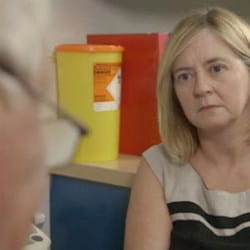DAY ONE
Mr G, 56, presents at a minor injuries unit with a painful ankle and is seen by a triage nurse. He says he had been dancing at a wedding four days previous and woke the next morning with pain and swelling. On examination swelling is noted to the lateral malleolus but no bruising, erythema or deformity is evident. Pain is noted on palpation of the posterior talofibular ligament and Achilles tendon. Mr G demonstrates a full range of movement in his ankle/foot and can weight-bear with a limp. The nurse diagnoses ankle sprain and advises rest and joint elevation with ice packs. Mr G is advised to return for review or to see his GP.
DAY SEVEN
Mr G attends his GP practice and is seen by Dr P. He complains of a painful ankle and in particular his Achilles tendon. The GP notes swelling and some minor bruising in the lateral aspect of the foot. He records that on examination there is tenderness in the Achilles region but no “step” in the tendon. He prescribes an NSAID with PPI cover and recommends Mr G to persevere with the ice and joint elevation. He recommends a physio who provides telephone advice on gentle exercises and pain management.
DAY 36
Mr G returns to the practice and is seen by another GP – Dr J – who specialises in sports injuries. The GP records that the patient has experienced ankle pain for the last five weeks since an injury while dancing on a slippery floor. The patient recalls feeling a “sudden snap” with sharp pain. Examination reveals a negative Thompson’s sign and a “step” in the Achilles tendon. Dr J diagnoses a ruptured Achilles tendon and refers the patient to the local orthopaedic clinic.
DAY 37
An orthopaedic registrar examines Mr G and confirms the diagnosis. On advice the patient opts for non-surgical treatment with a “moon boot” and periodic review.
SIX MONTHS LATER
Mr G is still suffering with pain and difficulty walking. There is still a step in the tendon with grossly reduced plantar flexion, and he cannot weight-bear on his toes. He undergoes surgery and is found to have a total rupture with a 2cm gap. Surgical reconstruction is undertaken using a flexor hallucis longus tendon transfer and the patient endures lengthy rehabilitation.
A LETTER of claim for damages is sent to Dr P alleging clinical negligence in the delayed diagnosis and referral of Mr G for a ruptured Achilles tendon. The letter cites a specific failure to adequately examine him and perform a Thompson or tiptoe test. This led to delayed treatment necessitating secondary reconstruction using tendon transfer, with additional pain, reduced range of movement and restricted mobility in the big toe.
MDDUS commissions a GP expert whose analysis of the case file notes that in the letter of claim Mr G insists he described a sudden sharp pain or “snap” in his ankle while dancing, but in the notes from the triage nurse and Dr P there is no specific mention of the point of injury – only a brief description of “ankle pain/swelling”.
The expert also observes that Mr G’s examination did focus in part on the Achilles tendon but that “no step” was noted. But in his view there is some legal “vulnerability” in not having also asked Mr G to “stand on his tiptoes” with follow-up employing the Thompson test. This would have been crucial if Mr G had mentioned acute pain on injury. The factual dispute is a matter for the court but a negative Thompson should have prompted referral.
A consultant orthopaedic surgeon is asked to comment on causation (consequences of any breach of duty of care). He opines that an urgent referral after Dr P’s consultation would have led to a prompt diagnosis of Achilles tendon rupture and direct primary repair – generally indicated within four weeks of injury. This would have prevented the need for the later more extensive surgical reconstruction with subsequent pain, recovery and loss of mobility in the big toe.
Given doubt over the reported nature of the patient’s injury, the factual dispute and Dr P having not conducted further tests other than palpation of the Achilles tendon, MDDUS seeks to settle the case with no admission of liability.
KEY POINTS
- Ensure notes record the specific mechanism of injury and nature of pain.
- If a specific injury is part of the differential diagnosis list, ensure that specific examination is undertaken in an attempt to investigate this potential.
- Justify clinical decisions in the notes even if that includes taking no action.
This page was correct at the time of publication. Any guidance is intended as general guidance for members only. If you are a member and need specific advice relating to your own circumstances, please contact one of our advisers.
Read more from this issue of Insight Primary

Save this article
Save this article to a list of favourite articles which members can access in their account.
Save to library

